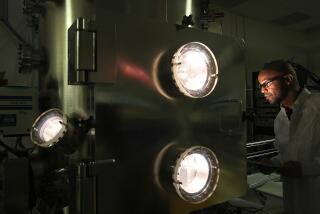Lockheed Will Consolidate Its 3 Aircraft Companies : New Entity to Be Headquartered in Burbank; Bleak Future for the Military Market Spurs Firm’s Move
- Share via
In a reorganization brought on by an approaching downturn in the military aircraft market, Lockheed said Thursday that it is consolidating its three aircraft companies into a single entity with headquarters in Burbank.
Although the move has no immediate effect on Lockheed’s 42,000 aircraft employees at facilities in seven states, the firm is hoping that “duplication” at its various plants can be eliminated and that employment can be reduced.
The restructuring will shift all of Lockheed’s aircraft design and engineering activities to facilities in Burbank and Rye Canyon, a sprawling Lockheed aerospace research center near Valencia. Previously, the research had been carried out by all three companies.
“The intent here is to get our costs down by centralizing research and development,” Lockheed President Lawrence O. Kitchen said in a telephone interview. “We are spending a lot of capital funds, but spreading it around the country. This way, we will concentrate it.”
Kitchen said he could not quantify the reductions in employment but added that the company hopes they can be handled over an unspecified period of time though retirement and attrition. In addition, “surplus facilities” will be eliminated, but those have not been identified, he said.
Others Face Problem
The impetus comes from an outlook for little significant growth in defense budgets over the next decade and few if any major new aircraft programs. It has left the aircraft industry with dozens of under-utilized facilities across the country.
“This is a real loss of muscle tissue, any way you describe it,” said Wolfgang Demisch, aerospace analyst at the First Boston investment firm in New York. “You can call it overhead, but it represents lost design capacity and lost production capacity.”
As much as 100 million square feet of surplus aircraft production capacity exists in the United States, Demisch said. A number of aerospace firms are facing difficult decisions similar to Lockheed’s, he added.
Lockheed’s announcement was not unexpected. Kitchen had indicated earlier this year at the firm’s annual shareholders meeting that it was studying its organization. A few years ago, the company announced a similar reorganization, but never fully implemented it.
Under the new organization, Lockheed’s aircraft business will operate as the Lockheed Aeronautical Systems Co. John C. Brizendine, 62, will be president of the company, a position that closely parallels his present job as president of Lockheed’s Aeronautical Systems Group, which he has held since last year.
The restructuring will effectively downgrade the Lockheed-Georgia Co. and the Lockheed Services Co. to the status of operating divisions that report to Burbank and are not involved in technical work.
Lockheed-Georgia, which employs 20,300 workers, produces military cargo planes, including the C-130 and the C-5B. But the last C-5B will be delivered in 1989 and Lockheed does not have a program to take up the slack, Kitchen said. The C-130 is expected to continue in production through the 1990s, he said.
“What we would envision the Georgia company becoming is a major production facility, a producer rather than a developer,” he said.
Lockheed Services employs 3,200 people in aircraft modification and maintenance at facilities in Ontario, Upland and Chino. The modification work includes systems for electronic defense, and command, control and communications. The unit also has facilities in Texas and South Carolina.
Despite the expected slowdown in government defense spending, Lockheed’s fortunes could turn up sharply. The company is prime contractor on development of the Air Force’s Advanced Tactical Fighter and is in competition with Northrop for an eventual production contract.
If it is successful, it could realize about $55 billion in future business.
But other major programs are already awarded and few fresh starts are expected. As a result, Lockheed is aiming to supplement its aircraft production with subcontracting work and co-production.
It recently won a $1.3-billion subcontract from McDonnell Douglas to produce wings for the C-17 transport aircraft. Kitchen wants to significantly enlarge that part of Lockheed’s business.
“It is a market we haven’t been in, not in the recent years,” he said. “Once we lower our costs, then we can go after subcontracting and second-source work.”
Kitchen identified tactical missiles as one area in which the company will be bidding for second-source production contracts.
More to Read
Inside the business of entertainment
The Wide Shot brings you news, analysis and insights on everything from streaming wars to production — and what it all means for the future.
You may occasionally receive promotional content from the Los Angeles Times.











